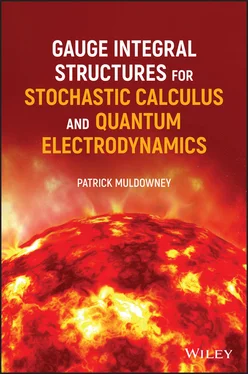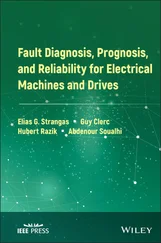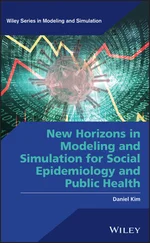Patrick Muldowney - Gauge Integral Structures for Stochastic Calculus and Quantum Electrodynamics
Здесь есть возможность читать онлайн «Patrick Muldowney - Gauge Integral Structures for Stochastic Calculus and Quantum Electrodynamics» — ознакомительный отрывок электронной книги совершенно бесплатно, а после прочтения отрывка купить полную версию. В некоторых случаях можно слушать аудио, скачать через торрент в формате fb2 и присутствует краткое содержание. Жанр: unrecognised, на английском языке. Описание произведения, (предисловие) а так же отзывы посетителей доступны на портале библиотеки ЛибКат.
- Название:Gauge Integral Structures for Stochastic Calculus and Quantum Electrodynamics
- Автор:
- Жанр:
- Год:неизвестен
- ISBN:нет данных
- Рейтинг книги:3 / 5. Голосов: 1
-
Избранное:Добавить в избранное
- Отзывы:
-
Ваша оценка:
Gauge Integral Structures for Stochastic Calculus and Quantum Electrodynamics: краткое содержание, описание и аннотация
Предлагаем к чтению аннотацию, описание, краткое содержание или предисловие (зависит от того, что написал сам автор книги «Gauge Integral Structures for Stochastic Calculus and Quantum Electrodynamics»). Если вы не нашли необходимую информацию о книге — напишите в комментариях, мы постараемся отыскать её.
, left off,
introduces readers to particular problems of integration in the probability-like theory of quantum mechanics. Written as a motivational explanation of the key points of the underlying mathematical theory, and including ample illustrations of the calculus, this book relies heavily on the mathematical theory set out in the author’s previous work. That said, this work stands alone and does not require a reading of
in order to be understandable.
Gauge Integral Structures for Stochastic Calculus and Quantum Electrodynamics Stochastic calculus, including discussions of random variation, integration and probability, and stochastic processes. Field theory, including discussions of gauges for product spaces and quantum electrodynamics. Robust and thorough appendices, examples, illustrations, and introductions for each of the concepts discussed within. An introduction to basic gauge integral theory. The methods employed in this book show, for instance, that it is no longer necessary to resort to unreliable «Black Box» theory in financial calculus; that full mathematical rigor can now be combined with clarity and simplicity. Perfect for students and academics with even a passing interest in the application of the gauge integral technique pioneered by R. Henstock and J. Kurzweil,
is an illuminating and insightful exploration of the complex mathematical topics contained within.

 (denoting stochastic sum) on page below. Section 13.4 has a list of the main symbols used.
(denoting stochastic sum) on page below. Section 13.4 has a list of the main symbols used. ,
,  , in the theory of probability (including quantum mechanics), where
, in the theory of probability (including quantum mechanics), where  is the set of real numbers, and
is the set of real numbers, and  is an interval of time.
is an interval of time. , as domains for integration of functions
, as domains for integration of functions  ,
,
 will generally represent time, it is also used as an arbitrary finite or infinite set of labels
will generally represent time, it is also used as an arbitrary finite or infinite set of labels  , depending on the context.
, depending on the context. has two components: domain
has two components: domain  , and integrand
, and integrand  . When
. When  is an infinite set, such as an interval of time, two different perspectives are present. These are the perspectives indicated in figures 3.1 and 3.2 on page 87 of [MTRV].
is an infinite set, such as an interval of time, two different perspectives are present. These are the perspectives indicated in figures 3.1 and 3.2 on page 87 of [MTRV]. where
where  is an argument of integrand
is an argument of integrand  . Figure 3.2 represents the domain
. Figure 3.2 represents the domain  whose elements
whose elements  are points, not graphs. Both of these perspectives should be kept in mind while using this book.
are points, not graphs. Both of these perspectives should be kept in mind while using this book. and
and  , so
, so  . In this case, for integrands
. In this case, for integrands  which appear in this book, there may be little difference between the values of integrands
which appear in this book, there may be little difference between the values of integrands  in domain
in domain  , and
, and  in
in  if
if  is continuous.
is continuous. and
and 
 are very different; just as
are very different; just as  differs geometrically from
differs geometrically from  ,
,  . The latter difference is the vehicle for the 19th century satire Flatland by Edwin A. Abbott [1], in which two‐dimensional beings struggle with the idea of a three‐dimensional universe.
. The latter difference is the vehicle for the 19th century satire Flatland by Edwin A. Abbott [1], in which two‐dimensional beings struggle with the idea of a three‐dimensional universe.










